the reason many still prefer passive originals against tweaked to active systems is imho due to that active xovers designed after textbook don't suffice to deal with the driver requirements.
I think maybe you are talking about commercial, off-the-shelf passive crossovers. In this case you are right, of course. You can't do the right things with just a frequency and level adjustment meant for generic speakers. Works pretty well in commercial settings though. 🙂
There's several good options though:
Rolling your own with all the features. This is what Linkwitz does for his OB setups. In fact, I'm not sure you can do good OB without one.
- Using a hybrid approach where you remove the HP and LP components while keeping EQ features.
The two major challenges, IMHO though are the volume and power supply. Keeping 4-6 channels tracking accurately can get expensive, and you can go completely nuts trying to get the blackest black power supply that can support the 12 NE5532's ( a great Op Amp in almost every signal chain of everything you hear recorded ) you'll be using.
The miniDSP solutions are out there as well of course. The challenge there is affording enough D/A converters, and figuring out how to get the volume into the analog domain for all those channels.
My favorite solution so far though is the active amplifier with a built in DSP crossover and EQ such as from Hypex. Very cost effective, especially when you realize you will no longer be buying exotic (aka boutique) crossover parts or another pair of amplifiers for your living room.
Best,
Erik
Last edited:
@Erik
Rolling your own active analogue crossovers is much more complicated than most here seem to think. Try to design an active filter with two poles, including baffle step compensation and some notching. First of all one must choose the right active topology. Not a trivial job. Standard S&K opamp configurations are certainly not going to cut it, leading to fairly complex circuitry.
And then after all that: only a few programs are able to optimize active circuitry loaded by a real .frd file, such as Caldsod, SoundEasy, LspCad and LEAP.
Component sensitivity then is next obstacle to be conquered, and is a real issue with active filters. This is way beyond the average amateur.
Even otherwise reliable sources such as Rod Elliot unfortunately produce only textbook filter slopes, that only work with ruler-straight spl curves and drivers with identical acoustical centres. In reality your summed response with such textbook filters will be some 10 to 15 db off at various frequencies, i.e all over the place.
This is exactly why Minidsp, Hypex, Najda and other DSP filters have become so popular: thy can be optimized at will to any driver/filter requirement behind the PC screen.
Good luck,
Eelco
Rolling your own active analogue crossovers is much more complicated than most here seem to think. Try to design an active filter with two poles, including baffle step compensation and some notching. First of all one must choose the right active topology. Not a trivial job. Standard S&K opamp configurations are certainly not going to cut it, leading to fairly complex circuitry.
And then after all that: only a few programs are able to optimize active circuitry loaded by a real .frd file, such as Caldsod, SoundEasy, LspCad and LEAP.
Component sensitivity then is next obstacle to be conquered, and is a real issue with active filters. This is way beyond the average amateur.
Even otherwise reliable sources such as Rod Elliot unfortunately produce only textbook filter slopes, that only work with ruler-straight spl curves and drivers with identical acoustical centres. In reality your summed response with such textbook filters will be some 10 to 15 db off at various frequencies, i.e all over the place.
This is exactly why Minidsp, Hypex, Najda and other DSP filters have become so popular: thy can be optimized at will to any driver/filter requirement behind the PC screen.
Good luck,
Eelco
I agree with much of what is written above ^^^
However, I have designed a 4th order + BSC analogue active filter using the S&K topology, and it works very well indeed. So it can certainly be done well - it's just not mouse click software GUI configurable like DSP.
So it is less flexible (employing a zero defect mindset and spending the time in initial design phase helps design correctly first time) but flexibility only matters if you got something wrong, or need the system to cater for many designs at the touch of buttons.
In my experience (one active design, a revamp of the original passive design) the improvement in bass attack and treble clarity was easily identified (despite an almost identical filter response.
So if you want to use analogue, go ahead, its more work,but just as rewarding.
However, I have designed a 4th order + BSC analogue active filter using the S&K topology, and it works very well indeed. So it can certainly be done well - it's just not mouse click software GUI configurable like DSP.
So it is less flexible (employing a zero defect mindset and spending the time in initial design phase helps design correctly first time) but flexibility only matters if you got something wrong, or need the system to cater for many designs at the touch of buttons.
In my experience (one active design, a revamp of the original passive design) the improvement in bass attack and treble clarity was easily identified (despite an almost identical filter response.
So if you want to use analogue, go ahead, its more work,but just as rewarding.
@Erik
Rolling your own active analogue crossovers is much more complicated than most here seem to think. Try to design an active filter with two poles, including baffle step compensation and some notching. First of all one must choose the right active topology. Not a trivial job. Standard S&K opamp configurations are certainly not going to cut it, leading to fairly complex circuitry.
And then after all that: only a few programs are able to optimize active circuitry loaded by a real .frd file, such as Caldsod, SoundEasy, LspCad and LEAP.
Component sensitivity then is next obstacle to be conquered, and is a real issue with active filters. This is way beyond the average amateur.
Even otherwise reliable sources such as Rod Elliot unfortunately produce only textbook filter slopes, that only work with ruler-straight spl curves and drivers with identical acoustical centres. In reality your summed response with such textbook filters will be some 10 to 15 db off at various frequencies, i.e all over the place.
This is exactly why Minidsp, Hypex, Najda and other DSP filters have become so popular: thy can be optimized at will to any driver/filter requirement behind the PC screen.
Good luck,
Eelco
Hi Eelco,
Thanks for that. You bring up some interesting points, and are spot on. I had not thought about how much I rely on tools like XSim for passive crossover design, or how difficult it would be to do this in an active circuit. I was only thinking of the cook-book examples. Remember the Radio Shack "Op-Amp" cookbook?
Now that I think about it, you are completely right. I'd be pretty lost without an active, and real time simulation tool. You can simulate the electrical parts with free online tools such as PartSim but combining that with the acoustical properties of the drivers and cabinet is something else entirely.
Hello Mondogenerator,
Would you be willing to share your circuitry and show the filter+ drivers (acoustic) summed SPL results? I am really curious about the results.
A couple of years ago I tried to re-dimension the WW&E Bill Harman 8th order Bainter notch filter (this filter was hailed by some here on DIYA years ago) for a real 165 mm and a 25 mm dome, using measured .frd files. Calsod had a very, very hard time dealing with the optimization process..
Regards,
Eelco
Would you be willing to share your circuitry and show the filter+ drivers (acoustic) summed SPL results? I am really curious about the results.
A couple of years ago I tried to re-dimension the WW&E Bill Harman 8th order Bainter notch filter (this filter was hailed by some here on DIYA years ago) for a real 165 mm and a 25 mm dome, using measured .frd files. Calsod had a very, very hard time dealing with the optimization process..
Regards,
Eelco
This quote captures my general sentiment:
This expounds on that idea:
With either passive or active crossovers, you MUST DESIGN THE CROSSOVER FOR THE LOUDSPEAKER not just use whatever you think will work well. Otherwise you are no better than a monkey and your success rate will trend to about 50%.
Do it right and design the crossover using measured data so that you actually can get it right, no matter active OR passive.
By the way, if noise is a concern for active crossovers you might consider using a buffer-driven passive line-level crossover network.
The main issue is not active or passive, it's whether one knows what to do with either. Not like the problem would be solved just by choosing the "right" way to do it.
This expounds on that idea:
Hi,
the reason many still prefer passive originals against tweaked to active systems is imho due to that active xovers designed after textbook don't suffice to deal with the driver requirements.
Sangram pointed towards the reason.
Almost any driver requires some kind of equalization to achieve the desired acoustic filter response.
Now most simple active xovers don't feature EQs at all and only a few allow for very basic equing ... and those EQs are then again designed after textbook.
If You design a xover plus EQs in textbook fashion the parts number count may rise considerably.
Out of conviniance and the rising requirements in board space and overall effort most designers then use integrated OPAmps as active devices.
Don't be astonished if such a graveyard of parts doesn't sound natural or authentic at all.
Passive xovers on the other hand are typically designed specifically to the driver's requirements.
Additionally they tend to combine xover and EQ functionality in the aim to reduce component number count.
I'm not overly surprised if some listeners prefer a passive box over a active system designed after above mentioned rules.
DSP xovers on the other hand share similarities with passive xovers in the way the signal is handled.
Once the signal is in the digital domain all filtering and equing is done in one step/device before the final DA conversion.
The result can be astonishingly good even with the cheaper models, but in the end the cheap codecs used for adda limit those devices.
I'm quite sure that the DSP part, the filtering is acoustically fully transparent and any sonic fingerprint due to the sound character of the associated ADCs and DACs.
If You want to stay with analog xovers I'd suggest to deviate from textbook filters and to try to design as You'd do with a passive xover.
Filter and EQ functionality can be combined and parts number count -and active stages number count- can be reduced considerably.
I prefer to use unity gain filter structures and to replace the common OPAmp -connected as follower for a gain of 1- by a discrete Buffer, for example a simple JFET-CCS loaded JFET-follower.
Such designed xovers sounded always more authentic and natural to my ears ... Music instead of HiFi.
jauu
Calvin
With either passive or active crossovers, you MUST DESIGN THE CROSSOVER FOR THE LOUDSPEAKER not just use whatever you think will work well. Otherwise you are no better than a monkey and your success rate will trend to about 50%.
Do it right and design the crossover using measured data so that you actually can get it right, no matter active OR passive.
By the way, if noise is a concern for active crossovers you might consider using a buffer-driven passive line-level crossover network.
If you are a purist perhaps you could design the ultimate crossover using DSP and then create the equivalent crossover using active and/or passive components. For ten-thumbed (all of them burned by soldering iron 🙂 ) like Soldermizer, I will stick with MiniDSP and equivalent 🙄
Sent from my NV570P using Tapatalk
Sent from my NV570P using Tapatalk
Hi Doug Kim,
A really good book on active crossovers is Douglas Self's book "The design of active crossovers" Go to page 9 in the link below for a list of advantages.
https://books.google.co.uk/books?id=E01DvO2nsH0C&pg=PA1&source=gbs_toc_r&cad=2#v=onepage&q&f=false
Have fun.
Peter
A really good book on active crossovers is Douglas Self's book "The design of active crossovers" Go to page 9 in the link below for a list of advantages.
https://books.google.co.uk/books?id=E01DvO2nsH0C&pg=PA1&source=gbs_toc_r&cad=2#v=onepage&q&f=false
Have fun.
Peter
If you are a purist perhaps you could design the ultimate crossover using DSP and then create the equivalent crossover using active and/or passive components. For ten-thumbed (all of them burned by soldering iron 🙂 ) like Soldermizer, I will stick with MiniDSP and equivalent 🙄
Sent from my NV570P using Tapatalk
That's what I did here for a Harsch XO with my PMC inspired TL. I did it with miniDSP for the EQ and the XO, then made the equivalent in passives and it took a lot of components to shape it the way the DSP did.
http://www.diyaudio.com/forums/multi-way/281778-low-cost-pmc-inspired-tl-monitor-dc130a-dc28f.html
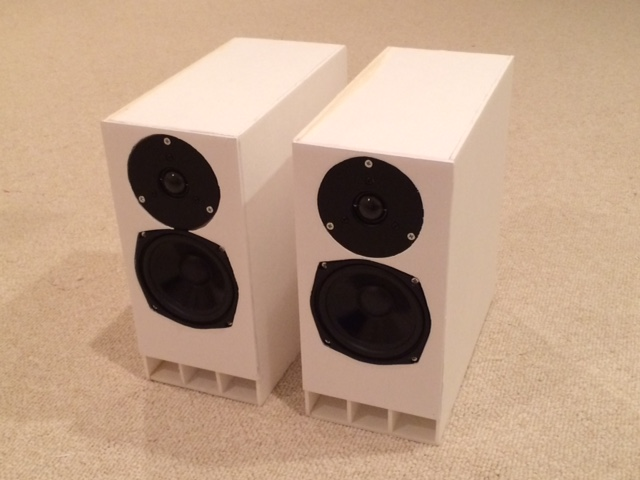
Here is the measured acoustic XO with miniDSP:
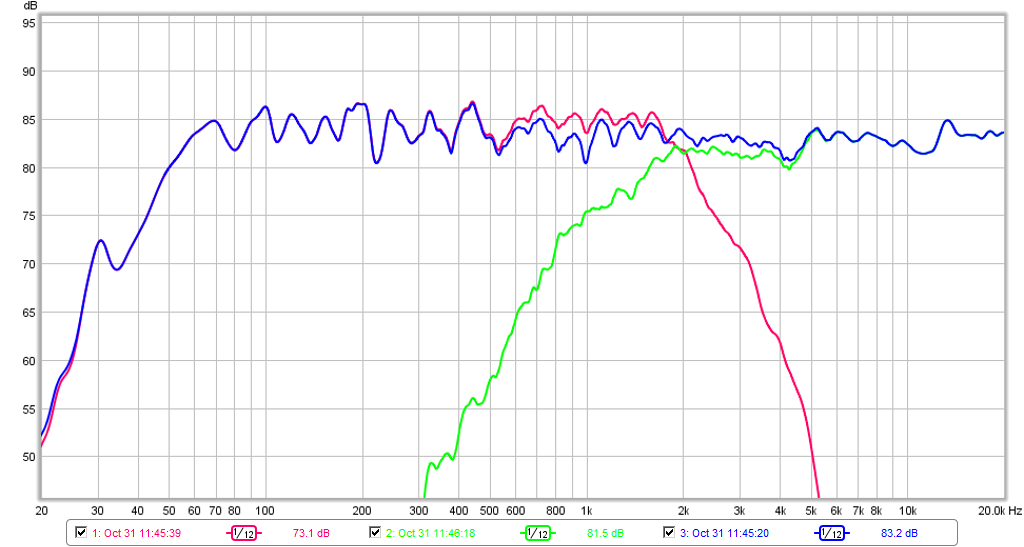
Impulse and Step Response:
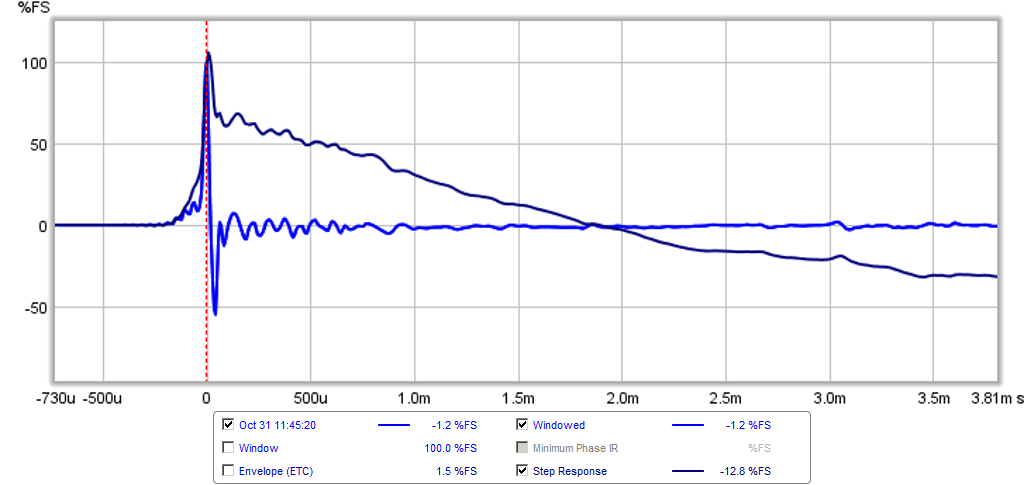
Then here is what the design looks like with passives (crazy parts count! Perhaps a better more well-behaved woofer would have saved me all those notch filters?):
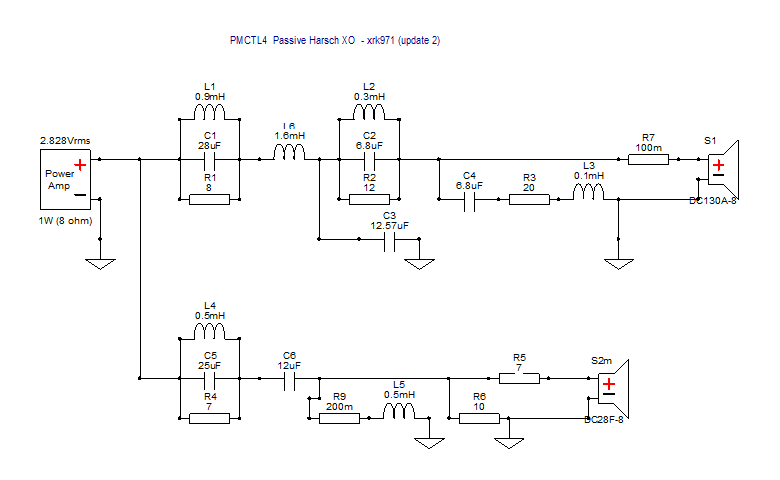
Predicted response:
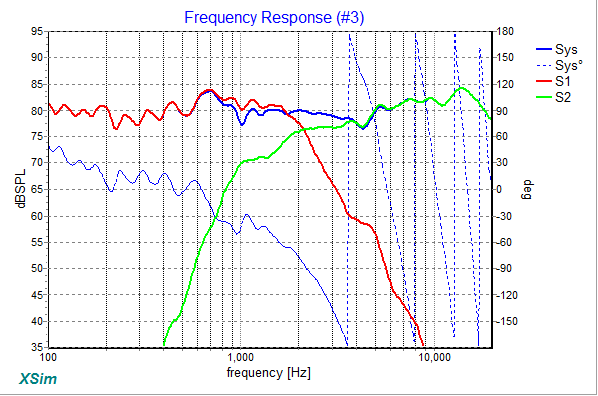
Predicted Step Response:
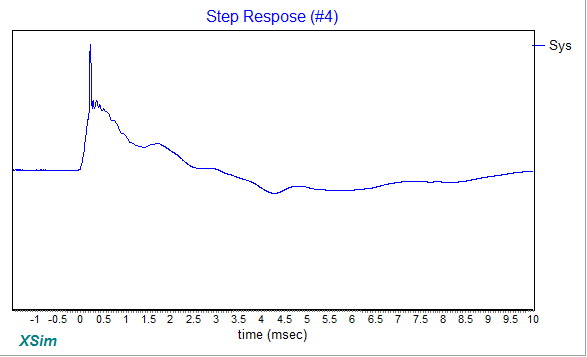
These speakers sound superb by the way, when placed on my desk as nearfield monitors, they have bass capability way beyond their size suggests. That's 0.8% THD for 87dB at 30Hz (table boundary gain). Coupled with the excellent quasi transient perfect time coherency, percussion sounds fantastic and imaging is very stable with a total phase shift of only 55 deg over the main bandwidth:
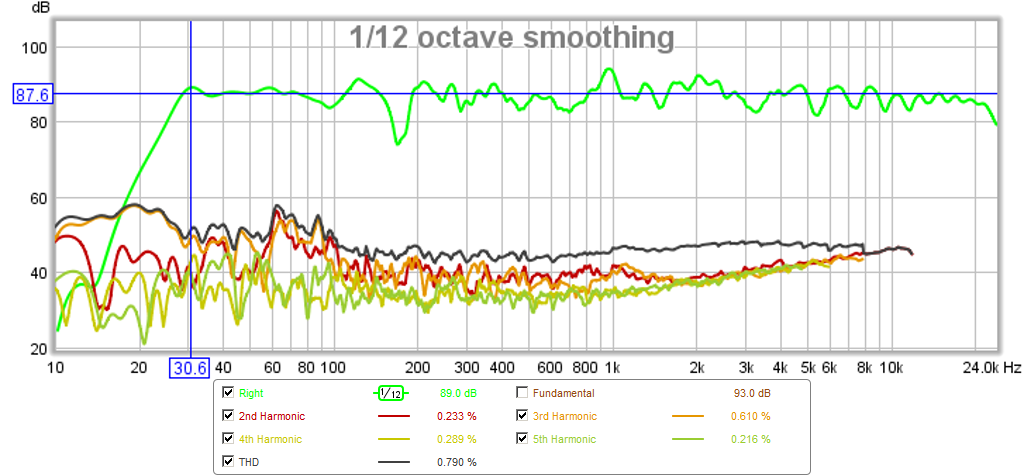
As you can imaging, due to the impractical parts count on the passive XO, I stayed with active.
Last edited:
Thank you for all of your suggestions, and sorry I cannot reply to them all.
Amongst all suggestions, I think I will try miniDSP first, and see if that's better (to me) than Rolls SX45 active crossover.
Amongst all suggestions, I think I will try miniDSP first, and see if that's better (to me) than Rolls SX45 active crossover.
So I would like to ask a question to those who has been using active crossover. Everything being equal (amp, source, speaker, etc), what circuit and its components (such as op amps, capacitors, etc) do I have to use for an active crossover to achieve equal or better sound quality (except the phase issue) of the equal order passive crossover?
Let's assume we can design a perfect crossover, active or passive...
With passive, the problem is that the extra component is an irregular and difficult load for the amplifier. As long as the amplifier is suitable/capable, the problem can be assumed minimal.
With active, the problem is that the filter itself is an active component with its own distortion and noise. Often it is more complicated than a preamp and amplifier.
Imagine you are using a simple stage low feedback tube pre-amp and amplifier and a high sensitivity speaker. Can you imagine what an op-amp based crossover do to the sound?
If your system has the cold sound of opamp or solid state, it is usually better to benefit from active crossover.
Quote: Imagine you are using a simple stage low feedback tube pre-amp and amplifier and a high sensitivity speaker. Can you imagine what an op-amp based crossover do to the sound?
No Jay, I frankly do not have a clue. Yet you seem to imply the result will be ear splitting.
I do not see what such statements contribute to the fairly decent discussion in this thread so far..
My whole point is -and remains- that designing a proper active mimic of a decent passive x/o including BSC, driver offset and some notching requires complicated circuitry and component matching.
In the 300+ pages of his book on active filters, to my best of knowledge Doug Self (who is definitely one of my heroes) does not show a single active x/o-real speaker combi SPL measurement. That says it all.
Good luck,
Eelco
No Jay, I frankly do not have a clue. Yet you seem to imply the result will be ear splitting.
I do not see what such statements contribute to the fairly decent discussion in this thread so far..
My whole point is -and remains- that designing a proper active mimic of a decent passive x/o including BSC, driver offset and some notching requires complicated circuitry and component matching.
In the 300+ pages of his book on active filters, to my best of knowledge Doug Self (who is definitely one of my heroes) does not show a single active x/o-real speaker combi SPL measurement. That says it all.
Good luck,
Eelco
Quote: Imagine you are using a simple stage low feedback tube pre-amp and amplifier and a high sensitivity speaker. Can you imagine what an op-amp based crossover do to the sound?
No Jay, I frankly do not have a clue. Yet you seem to imply the result will be ear splitting.
"Ear splitting" is a too strong words. But you have to "understand" (which means you can hear it) why there are different tastes in sound. Or why there is FB versus NFB camps. Opamp and No-opamp camps.
I do not see what such statements contribute to the fairly decent discussion in this thread so far..
There have been many similar discussions. But people seem to never "get it". Hence the statement.
My whole point is -and remains- that designing a proper active mimic of a decent passive x/o including BSC, driver offset and some notching requires complicated circuitry and component matching.
I know/understand what you are saying. And I agree with it. But do you think after this complicated circuitry and extreme component matching they will sound the same? No, they will not.
In the 300+ pages of his book on active filters, to my best of knowledge Doug Self (who is definitely one of my heroes) does not show a single active x/o-real speaker combi SPL measurement. That says it all.
What does it say exactly, I wonder?
it says that is difficult to get an active filter, say a two-way 4th order acoustic LR combined with e.g. a 165 mm midwoofer and a 25mm tweeter to properly sum to flat on axis, while retaining individual acoustic slopes that look like 4th order acoustic LR LP and HP.
Apart from Rdc of the coils in a passive LP, impacting woofer Qt, I fail to see why active should sound different (or even worse) than passive, in case acoustic (yes, acoustic, which is driver+filter!) slopes are identical.
Eelco
Apart from Rdc of the coils in a passive LP, impacting woofer Qt, I fail to see why active should sound different (or even worse) than passive, in case acoustic (yes, acoustic, which is driver+filter!) slopes are identical.
Eelco
Gentlemen we are getting into questions of belief and arguing about them question or demanding proof is as useless as demanding proof in religion. I claim objectivity, but right now i am listening to four $3 each drivers mounted in two filched plastic signs! Am I rational? Of course blind tests are possible, albeit unpopular 😁
Sent from my pc1162 using Tapatalk
Sent from my pc1162 using Tapatalk
At the risk of wandering into no mans land, these considerations normally keep the question of feedback close to the speaker interface.Or why there is FB versus NFB camps. Opamp and No-opamp camps.
I'm no stranger to making adjustments with an equaliser, and from time to time translating the bulk of these adjustments into a passive crossover. That means measuring the output of the EQ, applying this to a crossover target (careful where drivers overlap) and re-setting the EQ. The point is it's not difficult to find out.Am I rational? Of course blind tests are possible, albeit unpopular
Hello Mondogenerator,
Would you be willing to share your circuitry and show the filter+ drivers (acoustic) summed SPL results? I am really curious about the results.
A couple of years ago I tried to re-dimension the WW&E Bill Harman 8th order Bainter notch filter (this filter was hailed by some here on DIYA years ago) for a real 165 mm and a 25 mm dome, using measured .frd files. Calsod had a very, very hard time dealing with the optimization process..
Regards,
Eelco
Hi.
I have the Sims somewhere on my page, and a thread detailing the build.and design (however, the linked images in that thread are probably dead by now - it was 2 years ago when I wrote it)
I used Visaton Boxsim to design an active filter which yielded a result I was happy with in the acoustic simulation. Several plot tabs are available in Boxsim, and I exported the electrical filter response which corresponds to the simulated acoustic result.
Each stage Q and Fc was noted and the appropriate R and C values calculated to give the correct electrical (and hence also acoustic) response. I then followed by testing the circuit gave the desired electrical response, using a sig gen and Oscilloscope.
It was quite alot of work, since the values for R1,R2,C1 & C2 are all different (that is to say the method requires this, and breaking the usual 'shortcut' of equal R values)
In some cases, it may be easier to just use MF filters or other types to achieve a goal (and do so with less stages, as in many 3 way active crossovers) but for my 2 way design it hardly matters if I use 3 stages or more per driver per channel.
But to get good accuracy I used 0.1% R and 1% C. Using 5% R or even 2% tolerance, lead to noticeable errors.
I believe that is the real difficulty with S&K filters, and should I need to choose an order above 4th, id just Learn to use DSP or get better behaved drivers to start with.
I'll see if I can dig out all the method and links for you (in a PM if you'd like)
I fail to see why active should sound different (or even worse) than passive, in case acoustic (yes, acoustic, which is driver+filter!) slopes are identical.
So as long as the slope is identical, either with amp A or amp B, or crossover X or crossover Y, the sound should be identical?
Of course not. So what other criteria you want to add to make it true? Same phase? Try to add more.
- Status
- Not open for further replies.
- Home
- Loudspeakers
- Multi-Way
- What quality of active crossover will surpass passive?